You’ve found a fantastic high-demand, low-competition product, and a reliable supplier. But how do you get your product from the factory to an Amazon fulfillment center?
International shipping is one of the most complicated aspects of selling on Amazon. With many moving parts and legal requirements, it’s best to hire professionals to get your products safely from overseas to Amazon FBA.
In this article, we’ll go over what freight forwarders are, the benefits of hiring one, and how to find a reliable company to handle your shipment.
What is a freight forwarder?
A freight forwarding company helps businesses get their goods from their overseas manufacturer to an Amazon fulfillment center, a third-party fulfillment center, or a designated warehouse.
They coordinate the entire shipment process for you and as professional experts, know all the technical requirements needed to get your products through customs clearance and into Amazon.
Without a freight forwarder, it would be nearly impossible for the average person to arrange the shipment process independently. There are many laws and regulations involved when shipping internationally, so it’s best to let a freight forwarder manage the logistics on your behalf.
What is a customs broker?
A customs broker ensures that your goods clear customs during the shipment process by being the intermediary between you and customs. They inform the shipper of the necessary documentation to have the goods cleared and prepare and submit it to get clearance from customs.
A customs broker is essential because an issue at customs can delay your shipment.
Most freight forwarders offer brokerage services, so they can act as your customs broker. This saves you from having to hire a separate company.
Why hire a freight forwarder?
As private label sellers on Amazon, we all wish the international shipment process was much easier, but that is not the case.
A lot can go wrong for large, heavy shipments that require transport by sea or air, such as customs clearance delays or damaged cargo.
If you want to ensure that your products arrive from the factory to an Amazon fulfillment center safely and on time, it is best to hire a freight forwarder to manage every step of the process.
1) They arrange the entire shipment for you
When hiring a freight forwarder, you don’t have to do much about your shipment besides filling out some paperwork and paying for the shipment. An experienced forwarder will make sure your shipment gets to the final destination legally, safely, and efficiently.
Forwarders know what to expect throughout the process of each shipment. If you try to do this on your own, you may miss a critical step, potentially causing your product to be lost, confiscated, or delayed.
2) Forwarders are knowledgeable with all things shipping
Once you’ve done the hard part of finding a profitable product and a reliable supplier, the last thing you want is to deal with shipping companies, government agencies, and logistical issues. Freight forwarders have expert knowledge, experience, and best practices in the end-to-end shipping process.
3) They can insure your shipment
When shipping internationally, especially by sea, a lot can go wrong — even with a freight forwarder. Ensure the forwarding company you choose offers cargo insurance to give you additional protection if something happens to your products during shipping.
4) Customs clearance
Customs clearance is probably the most crucial benefit in hiring a freight forwarder. If your products get caught up in customs, this can delay your shipment delivery by weeks or even months.
When should you use a freight forwarder?
Now that you know what a freight forwarder is and what they can do for you, here’s our rule of thumb for when you need one:
If your shipment is less than 200kg
Don’t use a freight forwarder for shipments less than 200kg (440lbs). Have your supplier organize the shipment using a courier service such as DHL, FedEx, or UPS. Using a courier will be the most cost-effective and fastest way to receive your small shipment.
In this situation, the courier used to ship your products will act as the customs broker and deliver the goods to your final destination. FedEx/DHL may send you a bill for the customs/duty fees.
If your shipment is more than 200kg
Whether shipping by air or sea freight, use a freight forwarder if the shipment weighs over 200kg. It will be more cost-effective and save you many headaches.
If shipping by sea, you should always use a freight forwarder.
What does it cost to use a freight forwarder?
Since there are so many variables involved with the shipping process, such as types of products, weight, volume, and distance, it is difficult to estimate the cost accurately.
Generally, you can expect to pay around $1 per kilogram for a sea shipment, though the final cost will vary, depending on the total volume of your goods.
Shipping costs and times have also risen during the pandemic, so make sure you ask for the latest estimates and costs when doing your research.
To receive product shipping quotes from multiple freight forwarding companies, use a company like Freightos.com. We’ll go over this later in the article.
Shipping terms you should know
Here are a few shipping terms that you’ll likely encounter when working with a freight forwarder.
FOB (Free on board): This means your supplier is responsible for getting your goods from their factory to the shipping port. The supplier will ensure the goods are safely delivered to the departure port, where your freight forwarder will take ownership of the goods.
EXW (Ex-works): You/your freight forwarder is responsible for getting your goods from your supplier’s warehouse to the shipping port. You pay to have the goods picked up from your supplier and delivered to the port. You and your supplier will discuss these terms and decide if FOB or EXW is the right way to go.
FCL (Full container load): Your goods will take up an entire container. Your supplier will tell you that your products will ship in a container alone.
LCL (Less than container load): This means that your goods will ship inside a container with other companies’ products besides your own. If you don’t have enough products to take up a container, you’ll choose LCL.
Bill of lading: The master document for your shipment proving that you are the owner of the goods. This document is a shipment contract that your freight forwarder will issue. You will receive the bill of lading after the goods have been delivered.
Commercial invoice: The invoice given to you by your supplier that outlines your goods. The invoice will display what you ordered, the cost per unit, the supplier’s information, the buyer’s information, the HS code, as well as the shipping terms agreed upon.
HS code: This number can be found on your commercial invoice and is used to classify your product. This code will determine the duties you will need to pay.
Customs bond: The customs bond ensures payment of duties and money owed to customs officials. Your freight forwarder will have a customs bond and pay the duties owed on your behalf.
Questions to ask about freight forwarders
Use this list of questions when screening for a freight forwarding company for your business:
- Do they have Amazon FBA shipping experience?
- Can they work with smaller sellers?
- Do they offer cargo insurance?
- Can they handle every aspect of the shipping process?
- Will they provide a customs bond?
- Can they provide customs clearance?
- Can they get your goods from the destination port to an Amazon warehouse?
- Can they help label products according to Amazon’s requirements if needed?
- Do they communicate well?
- Do they charge a reasonable rate?
The shipping process
To help give you a better understanding of how the shipment process works, let’s go over the steps involved. Keep in mind that if you are using a freight forwarder, they will handle every step of this process — it’s just good to know how it works!
Step 1: Goods travel from the factory to the international port
You’ll have two options to work out with your supplier during this step. FOB (free on board) or EXW (ex-works). Your supplier may offer other shipping terms, so make sure you negotiate that with them.
The terms determine who is responsible for getting the goods from the factory to the shipping port. FOB is the easiest option in most cases as your supplier will make sure your goods reach the port. From there, your freight forwarder can handle the rest.
Step 2: Goods travel from international port to the destination port
Once your goods reach the port (let’s say, in China), they’ll begin the trip to your home port (let’s say, in the US). For this, you can choose air or sea freight, though we recommend shipping by sea as it will be much cheaper.
Sea shipment will cost you roughly $1 per kilogram and takes around 3-5 weeks to arrive.
Air shipment will cost you roughly $5 per kilogram and takes around 5-10 days to arrive.
Step 3: Goods arrive at the domestic port of entry and begin the customs clearing process
Once your products arrive at the port, customs begin the clearance process. This is where the help of a customs broker comes in, something you want your freight forwarder to take care of for you.
Before customs can clear your goods, you must pay the duties owed. Your broker/freight forwarder will handle this. Your freight forwarder will take care of any other documents that customs requires.
If all goes well, this process will take about a week.
Step 4: Goods need to be prepped for Amazon using a 3PL
Before your items can ship to Amazon’s fulfillment centers, your products need to be appropriately labeled and palletized according to Amazon’s requirements.
Once your product cases are palletized, you must label them with a shipment ID label. The label tells Amazon how many products are delivered and that the products belong to your seller account. You will get these labels after creating your shipment in Seller Central.
This is why it is crucial to work with a freight forwarder with Amazon FBA experience and one that can also serve as your 3PL to help streamline this process.
Note: If your products are exclusively sold on Amazon, have your supplier label each item with your product’s FNSKU code (Amazon barcode.) This will make the preparation process much more manageable.
Once your goods are prepped, they’re ready to be sent to Amazon. A decision that you need to make here is how your products will be shipped.
You can ship via SPD (small parcel delivery) with a local carrier such as UPS or by truckload shipping.
If your total shipment weighs less than 150 pounds, it will typically be cheaper to ship with SPD. Just know that there is a 200-case limit when creating a shipment via SPD.
If your shipment weighs more than 150 pounds, use LTL (less than truckload). Remember that Amazon has particular pallet requirements when shipping via truckload, so make sure your freight forwarder knows that.
Step 5: Get your goods to Amazon
Once your items are labeled and prepped, it is now time to get them to Amazon’s fulfillment centers!
This step, you’ll need to do on your own. Don’t worry — you can get any information you need regarding your shipment from your supplier or freight forwarder.
If shipping via SPD, you can use UPS and purchase the shipping labels right from Seller Central.
If shipping via LTL, you can use one of Amazon’s partners to arrange a truck to pick up your goods from the 3PL and deliver them to Amazon. Again, this is set up in your Seller Central account.
To learn how to set up a shipment in your Seller Central account properly, check out Episode 8 of our latest Million Dollar Case Study series:
Million Dollar Case Study S05: Episode 8 | On the Move… | Shipping Products to Amazon FBA
How to find a freight forwarder for Amazon FBA
Many freight forwarding companies can help you with your shipment, but how do you find them? At Jungle Scout, we recommend using Freightos.com.
Freightos provides you with quotes from multiple freight forwarders based on your product information and what you need so you can be sure you get the best price and service possible.
To begin, simply go to Freightos.com and click “Compare Rates Now.”
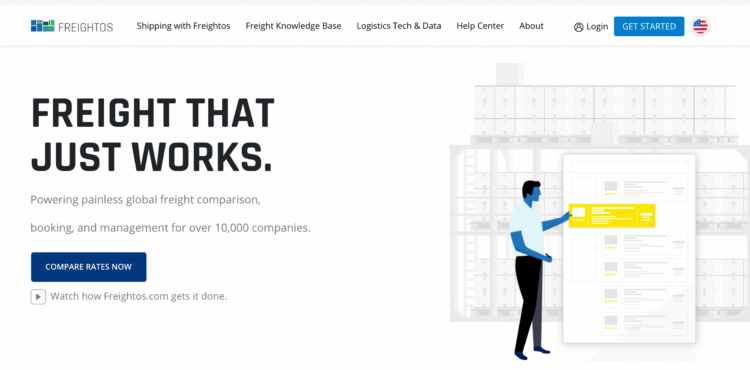
Enter the origin, destination, load, and type of goods on this page. For origin, this is where you enter your factory’s address. Simply ask them if you do not know it.
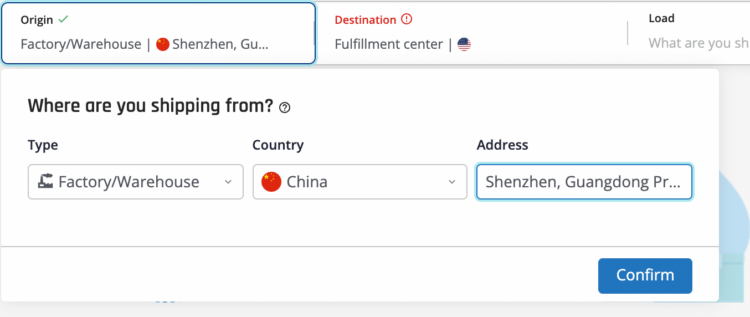
Next is the destination. You’ll have a few options here but if you want your products to be shipped directly to an Amazon fulfillment center, choose “Fulfillment center” in the dropdown menu.
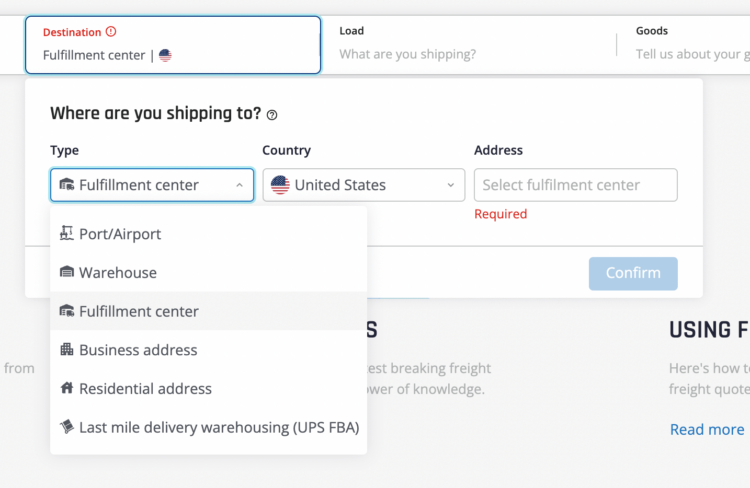
You also need to enter the fulfillment center address. At this point, you won’t have the address of your fulfillment center; simply pick one from the dropdown menu close to the port where your goods are shipped.
For example, if you’re having your goods delivered to the port in LA, choose a fulfillment center in California.
Once you find a freight forwarder to work with, let them know you will be changing that fulfillment center address once you have created a shipment in Seller Central.
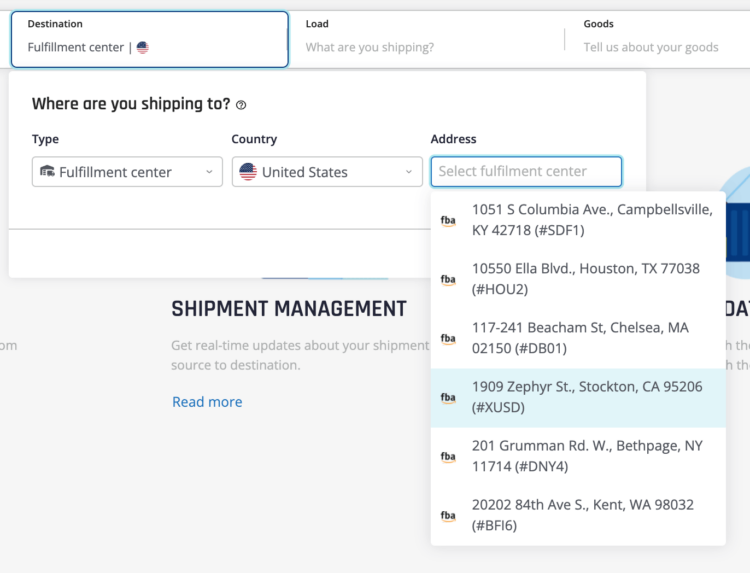
Next, enter what you’re shipping, such as pallets, boxes, or containers.
If you don’t have this information, make sure to contact your supplier to be sure everything is 100% accurate.
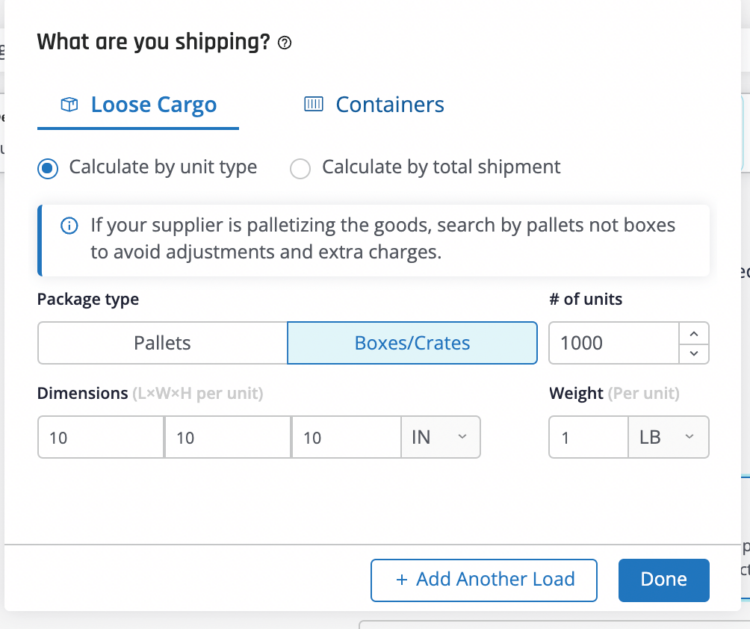
Lastly, enter the value of your goods and when they’ll be ready to ship. If you don’t know the total value, again, ask your supplier or look at your invoice.
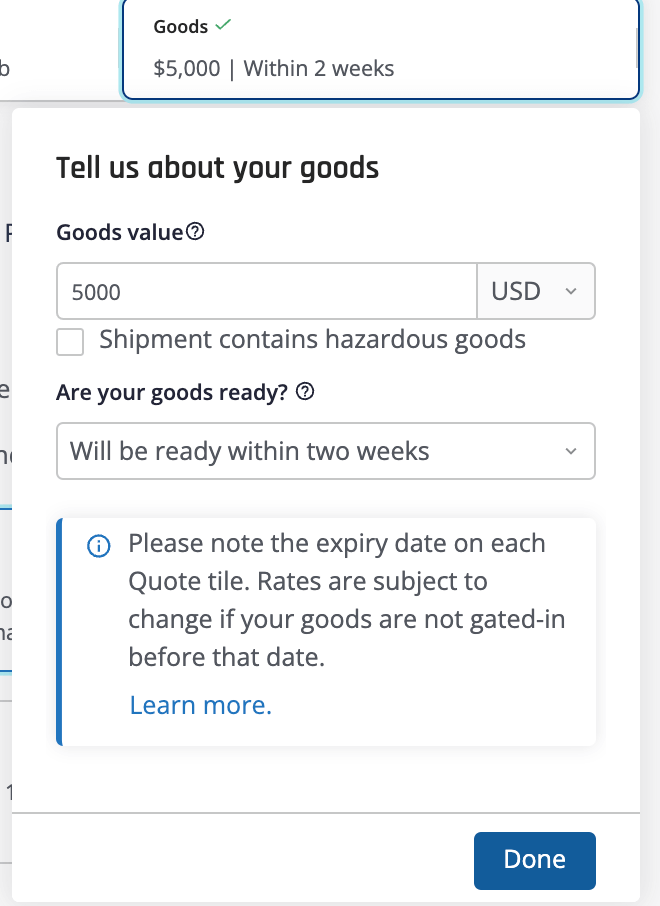
Before you get your results, Freightos will ask you if you need any services such as Amazon services and customs brokerage.
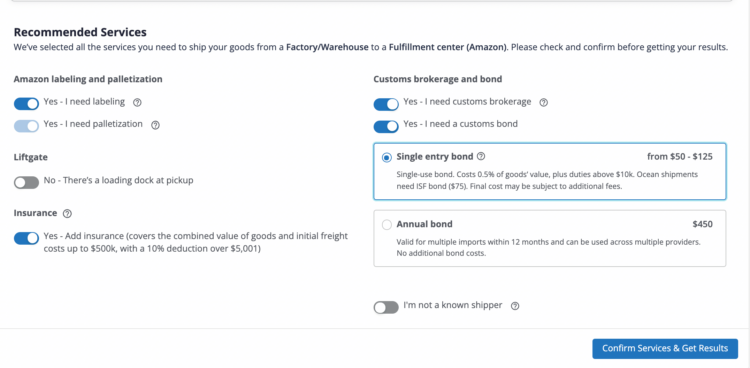
Unless your supplier will be labeling for you, I suggest choosing Yes for labeling and palletization. This way, you can be 100% sure your products are compliant with Amazon’s requirements.
For customs brokerage and bond, choose Yes for both options. You will need to have a bond when your goods reach the destination port.
After entering all this information, you will be presented with multiple freight forwarders to choose from.
Once you find a good freight forwarding company to work with, it’s time to set up your shipment in Seller Central!
To learn how to do it correctly, watch the video we added above or check out our latest How to Sell on Amazon FBA for Beginners video and watch the “Create a Shipping Plan” section.
How to Sell on Amazon FBA for Beginners | Complete Step-by-Step Guide by Jungle Scout (2022)
Now you’re ready to deliver the goods
When shipping your products from overseas into an Amazon fulfillment center, trust the professionals, and don’t ship alone. There are so many moving parts involved in this process that working with a freight forwarding company is worth the investment.
Finding a trusted partner in the shipping industry will make your life as an ecommerce seller that much easier.
If you have any more questions about freight forwarders or shipping your products, let us know in the comments below.
You can also check out our free Amazon FBA Competitive Edge Facebook group, where you can ask our experts and other Amazon sellers questions about freight forwarders and your FBA business.
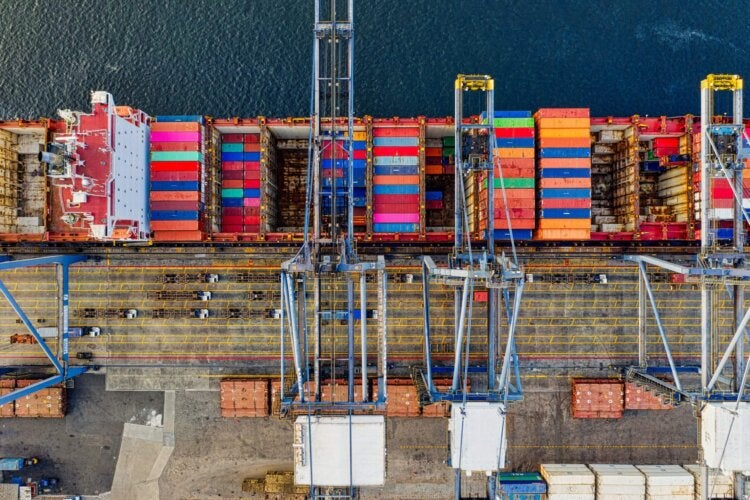

 46 Comments
46 Comments
46 comments on “Find the Best Freight Forwarders & Customs Brokers for Amazon FBA”
Thanks for sharing this blog with us very informative post keep sharing.
Hi, I’m a foreign vendor selling FBA on Amazon.com. We have a full 40ft container being shipped from a foreign port to to the port in New York, . USA
We are sending it to a 3PL after arrival, before shipping to the Amazon fulfilment centre in New Jersey.
We are specifying Amazon as the Ultimate Consignee and will be using their EIN.
Can my foreign company be named as the consignee on the Bill of Lading and for customs clearance, although Amazon is the ultimate consignee?
Hi Georgina,
I suggest speaking to your freight forwarder about this question.
Hi there,
This is our first time shipping to amazon. Hoping you can help us.
We have a full 40ft container being shipped from vietnam to the port in Houston. We then selected fedex to ship our products in seller central to the amazon fulfilment centre in Mississippi from the port.
My freight forwarder has asked the following questions:
-who will do the customs process in the states as there are power of attorney requirements as it can get a bit messy?
-Who will do the clearance?
Is this something my freight forwarder will take care of and their broker? It’s not something fedex will do is it?
Just confused with who does what. The freight forwarder can do it, just wasn’t sure if that was the easiest and most straightforward thing to do.
Thank you!
Hi Ashley,
I would let the freight forwarder handle all of that to avoid any issues once your products arrive.
Hi Brian… a BIG THANKS for all the info. It came at a perfect time. I’ve got a question. I’m just starting out. I’m planning to purchase 300 lightweight toys to sent to amazon fulfillment center. Based on what you said about the option of using ups as its a may well be under the weight you had mentioned. Once my supplier lable the goods, that’s all done in terms of paperworks and all ups would send to me is is the custom duty invoice to be paid, correct?
Hi Clinton,
Yes, that is correct. If shipping through UPS, they will send you a customs invoice to pay.
-Brian
good article
Thanks for reading!
Bgi is the best fwder they have the best price and warehouse prices that’s just my experience
Hi Brian, I have read your blog. I really appreciate the information you have provided. It helps me to grow my knowledge in this. Thank you for this.
Thanks so much for reading, Henry!
Hey,
We noticed your Article. We just loved it.
Great Advice! Your article has all the necessary details on the given topic. Thanks for sharing such excellent information on International freight shipment services. We also achieved success through immense care in planning and choosing the right resources and execution, be it the shipping services, cargo freight services and transportation to a clear title.
Hello,
If I’m starting out and my order is under $800, do you think it’s still important to get a freight forwarder or not? If not, any tips on things to look out for?
Many thanks!
Razan
For a small order like that, you shouldn’t need a freight forwarder.
looking for forwarder shipping my product to Canada FBA center
Hi there
I’m looking to get a quote on Air Freight and Air Express.
At the moment I’m organizing a product in China, located in Hangzhou, that needs to get into Amazon America. I’m unsure which warehouse of Amazon’s my product will go into as yet, however I just wanted to get a rough quote, so I can work my numbers at the back end.
The product will need to be picked up from the supplier at Hangzhou.
The dimensions of the carton are 54 x 39 x 25cms
There will be 12 cartons at 21kg each, therefore total will be 252kg.
If you require more information, please let me know.
At this stage I just need a rough idea of how much it’s going to cost me.
Thanks and look forward to hearing from you
Kylie Issa
Director
Mokoko Pty Ltd
0414 837 340
Hi Kylie,
You will need to contact a freight forwarder to get an accurate quote. Search on Google for freight forwarders to Amazon.
Hi, Im Zac. i have a product getting made in china, its a pet product, its made from pine wood and sisal rope. Im looking to import approx 35% shipping container worth. Will i or my supplier need a permit to import wood into USA ? will the wood need to be treated and meet certain requirements in order to successfully ship these products into the USA.
Thanks
Zac,
Hi Zac,
I am not sure about what the rules are regarding importing wood. I suggest doing some more research before so.
This blog is very useful for everyone. Thanks for sharing with us.
Great, we are glad you enjoyed it!
When do you pay for a DDP order, upon approval of inspection or delivered to warehouse?
Hi David,
Good question. DDP is usually paid for in advance if you’re doing it through your supplier. If you’re using a logistics company, it depends on them. My logistics company charges me before truck delivery.
Hello, I’m trying to figure out where to tell my freight forwarder what Amazon warehouse the shipment is going. I’m intimidated by all of this being my first shipment. Thank you
I live in New Zealand and my product is being manufactured in China and I am looking at shipping my product in full container loads into Amazon FBA in the US. In consideration of the proposed US tariffs on Chinese goods, where will these tariffs be collected, at what stage of the process do they have to be paid and are they charged on the ex-works price, the FOB price or the CIF landed price in the US?
Hey Peter,
Typically, you pay customs when they ender the US. The amount you pay is based on the manufacturer’s final invoice. I recommend working with your manufacturer and a customs agent to get you the possible set-up to avoid paying unnecessary fees and tariffs. Typically, customs agents make money by selling you bonds, so usually there’s no additional out-of-pocket expense.
Hope that’s helpful!
Excellent article, very interesting
Until now, the service that has worked most for me is freight by ship, it is certainly slower but I can transport more merchandise; King Ocean (www.kingocean.com) has accompanied me in this process and I am totally satisfied.
Very informative and useful content. Thanks for sharing.
Hi there!
Got a question about EXW and FOB price: i am about to order, its gross weight is going to be one ton roughly, my option is sea freight of course, this obviously won’t be a full container load, so in this case should i go for exw price to pay to my supplier? Since you mentioned fob works only with full container load.
Thanks
Hi Pasha,
Great question. You might consider speaking your supplier and/or a logistics company to figure out the best method for shipping for you.
All in all, it comes down what works best for your Amazon business.
Hope that’s helpful!
This blog post is very good and beautiful and also has a lot of information on it. Good and keep sharing your thoughts with everyone.
Very good post. thanks for sharing.
Kym,
Great article. I am trying to figure out if my supplier is trying to upsell me on ship costs. For an order of around 30-50kg, they are charging $400 USD for air express. Is this extremely high for an order that size? It is going China to FBA warehouse.
Thanks!
Hey Jay,
Typically we find that most suppliers don’t offer the best shipping rates, and we recommend researching and using freight forwarders to handle the shipping process. Of course, this doesn’t necessarily mean your supplier is trying to upsell, but it might be worth getting a few quotes from reliable forwarders to compare.
Melissa
I’m Australian and I’m unsure of customs procedures for the US. I’m looking at shipping directly from my Chinese supplier to an Amazon warehouse.
My supplier has organized their freight forwarder to do air shipment to the USA: (5-7working days).
The cost of my product is only $600. Does the $800 threshold apply to non-US citizens and do I have to buy a bond and sign a POA for the freight company or do they basically just take care of everything?
Hi Kym,
Just a quick question. When supplier uses UPS or FEDEX for door to door shipment for FBA. Does we still need a forwarder? Or both these companies sending through them will do all the documentations too. I am new and learning different terms and trying to understand different terminologies.
Regards,
Humbal
Hey Humbal,
Usually if you are shipping by Air (smaller quantities), then you can do this door to door via your courier. You will not need to use a freight forwarder in this case.
Air Freight is usually quite a bit more expensive than ocean, though. So it’s usually only used as a failsafe when you need stock fast, or for small orders of inventory.
A great tip I learnt from doing the Million Dollar Case Study is that you can ask your supplier to get air freight quotes for you – and they usually have a good relationship with some couriers and can help you find a good deal.
Hope this helps!
Kym
Hi there,
My supplier already does business in the US(distribution to brick & mortar stores), and has a US registered importer license. Are there freight-forwarders that can take goods from Dulles International Airport to designated FBA warehouses? Thanks!
Hi Kym!
Thank you so much for the article.
I have one question about the Freightos FBA free tool.
When I use the free tool I get one price (or three; Air, Express and Cargo).
But when I log in and get actual live quotes the prices are about 5-8 times as high as the Amazon FBA Calculator for Freight Rates.
I mailed Freightos and asked about that but they just replied to use the prices when I log in. I just wonder if you have experienced the same and if there is a “trick” that I might have missed to get the same rates as with the calculator you mentioned.
Best regards
Carl
Hey Carl,
I have noticed freight costs being more expensive this time of year whilst launching my product for MDCS Europe – so that could be a part of it.
One thing you can try is to see if your supplier can supply some quotes and compare that. You could also try getting some quotes directly with well known freight forwarders.
Hope this helps,
Kym
Hi there Jungle Scout I am trying to follow your “How To Ship: Best Practice” and going the courier route as my package is less than 150Kg. I understand this means it will be direct shipping from the suppliers factory to the Amazon FBA warehouse in the US and I should use EXW incoterm for it. Shouldn’t it be DDP instead to be safe so customs will be paid for?
When I go to SellerCentral to get the FNSKU I need to give to the supplier it asks for the “Ship From” address. I understand this is normally the US warehouse where your freight forwarder would be but since this is direct courier should this be the suppliers factory in china? Because that wouldn’t work for Amazon to find the nearest Fulfilment warehouse location since its FBA.
Hello Jungle Scout, I’d like to second Glenn’s question above. Where can I find the packing/shipping regulations necessary to ship directly to an FBA warehouse via DHL? Also, where can I find information on how to handle customs for DHL shipments to FBA?
Hello,
Thank you for all of this wonderful and pivotal information! I know this is an older post, but would you consider answering Amy’s questions above? I have very similar questions.
Thanks!
Thank you! This is really helpful.
I probably need to read the whole article another three times to fully digest all the info so please excuse me if I’m asking obvious questions…
1. I’m currently in a position where I need to re-stock one product and I’m looking in to another product, they are from different suppliers in China. From having a play around on the freight rate calculator it seems by ocean, rates don’t go up until you go over another weight threshold, therefore I could fit a lot more in for the same amount of money. So would it be possible for me to get stock from both suppliers in to the same shipment? i.e save on shipping costs on my second product.
2. I’m trying to work out how much all the extra costs will add up to… in your example of $2000 for air and $800 for ocean, can you give me a rough breakdown of what costs would look like for this i.e $500 for shipping, $150 for bonds, etc etc.
3. How much would you expect to pay a forwarder?
4. When you say U.S company tax I.D, would my U. S EIN be sufficient as we are a british company? or is this a problem?
Thanks so much!
Hey Amy,
In terms of merging two lots of inventory from two suppliers, I think you’d need to speak with both suppliers to find out if this would be possible. Not something I’ve seen before but I am sure it’s not impossible.
Costs for air/ocean freight will vary depending on your inventory, but you should be able to get a full breakdown quotation from your freight forwarder. Again, depending on what you are shipping and how much, your freight forwarder costs will vary – they usually just add a mark up on the total cost of shipping. I would ask them for a full breakdown of all of these costs ahead of time.
I think your US EIN should be sufficient to send to freight forwarders to get your quotes!
Hope this helps 🙂
Kym